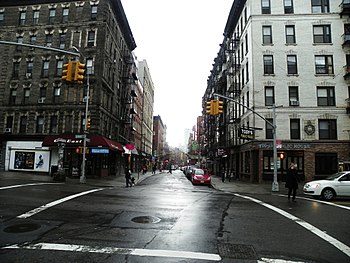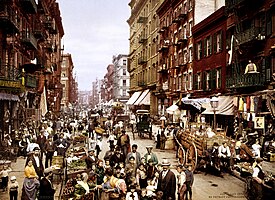
Back Mulberry Street (Manhattan) German Calle Mulberry (Manhattan) Spanish Mulberry Street (Manhattan) French Mulberry Street (Manhattan) ID マルベリー・ストリート (マンハッタン) Japanese Mulberry Street (New York) Dutch Mulberry Street (Manhattan) Portuguese Малберри-стрит (Манхэттен) Russian Mulberry Street Swedish Mulberry Caddesi (Manhattan) Turkish
 Mulberry Street in 2012 | |
 | |
| North end | Bleecker Street |
|---|---|
| South end | Worth Street |
| East | Mott Street |
| West | Baxter Street |

Mulberry Street is a principal thoroughfare in Lower Manhattan, New York City, United States. It is historically associated with Italian-American culture and history, and in the late 19th and early 20th centuries was the heart of Manhattan's Little Italy.
The street was listed on maps of the area since at least 1755. The "Bend" in Mulberry, where the street changes direction from southeast to northwest to a northerly direction, was made to avoid the wetlands surrounding the Collect Pond. During the period of the American Revolution, Mulberry Street was usually referred to as "Slaughter-house Street", named for the slaughterhouse of Nicholas Bayard on what is now the southwest corner of Mulberry and Bayard Streets, which was located there until the summer of 1784, when it was ordered to be removed to Corlaer's Hook.[1]
Mulberry Bend, formed by Mulberry Street on the east and Orange Street on the west, was historically part of the core of the infamous Five Points; the southwest corner of Mulberry Bend formed part of the Five Points intersection for which the neighborhood was named. Aside from Mulberry, the other four streets forming Five Points were Anthony Street (now Worth Street), Cross Street (now Mosco Street), Orange Street (now Baxter Street), and Little Water Street (which no longer exists).[2]
- ^ Staff (April 1, 1896). "Abattoirs; History of New-York Slaughter-Houses — Interesting and Curious Data" (PDF). The New York Times.
- ^ Herman, Michele "Five Points" in Jackson, Kenneth T., ed. (2010). The Encyclopedia of New York City (2nd ed.). New Haven: Yale University Press. ISBN 978-0-300-11465-2., p.456